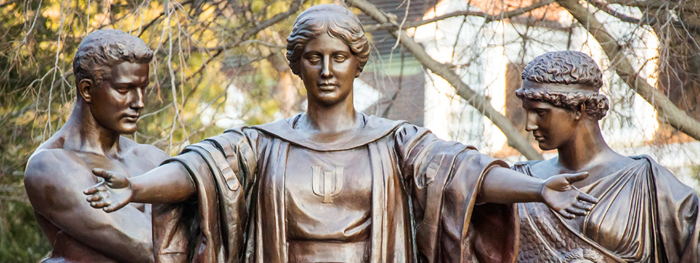Alumni Interview: Amanda McGrory
 Since retiring from wheelchair racing, McGrory works full-time as a Team USA Archives archivist and collections curator. She also has “a side gig in broadcasting, covering events like the Chicago Marathon and Boston Marathon for NBC and ESPN. I’m the first wheelchair racer to do so.” (Image by Parker Seibold)
Since retiring from wheelchair racing, McGrory works full-time as a Team USA Archives archivist and collections curator. She also has “a side gig in broadcasting, covering events like the Chicago Marathon and Boston Marathon for NBC and ESPN. I’m the first wheelchair racer to do so.” (Image by Parker Seibold) It’s summer 2016 in Rio de Janeiro, and I’m holding a Paralympic silver medal in the 1,500 meters. Beside me is my teammate Tatyana McFadden, ’13 ACES, EDM ’19, one arm around me and the other hoisting her gold medal. To her left, fellow Illini Chelsea McClammer, ’17 ACES, clutches bronze.
One podium, three training partners, three American flags—and one of the coolest moments of my life. We got there via a genius race plan from coach Adam Bleakney, ’00 LAS, MS ’02 MEDIA. Every step relied on one person taking a risk and someone else filling in. We pulled it off, and three days later, we did it again in the 5,000 meters. I don’t think this could have happened with another group of athletes or with another coach from another program. Years of work built up to this moment, for the team and for me.
I grew up a ball of energy in Kennett Square, about 45 minutes outside Philadelphia. One October morning at age 5, I walked downstairs for kindergarten and had trouble controlling my feet and legs.
My parents took me to the hospital. After two weeks of tests and specialist appointments, I was diagnosed with transverse myelitis. This rare inflammation of the spinal cord affects people differently. Some maintain the ability to walk, but a subset, like me, has a result like a spinal cord injury.
It was scary and difficult. Counselors advised my parents to accept and recognize my disability, but not to hold me to a lower standard. That was a huge gift.
My parents looked for opportunities to connect me to others with disabilities. I went to a summer camp, then started junior wheelchair basketball and wheelchair racing in Philadelphia.
“The legacy and performance of the Illini teams convinced me that it was Illinois or bust.” —Amanda McGrory, ’10 LAS, MS ’18 IS
For the first time, I was around active wheelchair users. They went to school, drove cars and had college degrees. I realized I could do those things, too.
I had already decided to be a Paralympian. My mom clipped newspaper articles for me during the Atlanta Games in 1996. One featured LeAnn Shannon, who set a world record in the 100 meters at age 14. That inspired me.
When it was time for college, I only considered schools with adaptive sports programs. The legacy and performance of the Illini teams convinced me that it was Illinois or bust.
I got a scholarship for wheelchair basketball but kept racing on the track. My sophomore year, 2006, I was getting frustrated with racing. I thought I was a sprinter like LeeAnn, but Adam suspected I’d excel at longer distances. He persuaded me to try the marathon—26.2 miles. In my second one, Grandma’s Marathon, I won and nearly broke the course record.
From there, things happened fast. I set a world record in the 5,000 meters. At the Beijing Paralympics in 2008, I won four medals, including gold in the 5,000 meters. I won the London Marathon, then won and set course records in Chicago and New York.
I had high expectations for the next Paralympics, 2012 in London, but came home empty-handed.
I almost quit. Instead, I changed everything—my racing chair position, my gloves, my diet. That’s another reason Rio was so special. It all paid off.
After Rio, I had more athletic success. Honda sponsored me and I won the 2017 Tokyo Marathon. At the same time, I finished my master’s degree in library science and did an internship at the U.S. Olympic & Paralympic Committee [USOPC].
I moved back to Illinois in December of 2018 to work part-time and train. Then, as the pandemic began, the USOPC archivist retired. A recruiter contacted me.
In July 2020, I should have been flying to Tokyo for my fourth Paralympic Games. Instead, I was moving to Colorado Springs to start as the archivist and collections curator for the Team USA Archives.
An archivist is a fancy librarian for rare and expensive stuff. Here, that means things like medals, torches and Serena Williams’ signed tennis shoes. As the Paris Olympics approaches, we fulfill requests for photos and loans from media outlets and museums. I’m also focusing on gathering new artifacts on the ground or when the athletes return.
I did compete in the rescheduled Tokyo Paralympics in 2021. Afterward, I retired as an athlete.
But along with my full-time job, I have a side gig in broadcasting, covering events like the Chicago Marathon and Boston Marathon for NBC and ESPN. I’m the first wheelchair racer to do so.
I barely have words for what this means. When I started as an athlete, wheelchair racers were rarely included in marathons. When we were, we got a tiny fraction of the runners’ prize purse. Now, there’s more representation and more money. I found out about the Paralympic Games from newspaper articles; these days, you can see it on TV.
I thought the hardest part of retiring would be watching this momentum continue without me. But with my work, I still get to share the sport I love with the world. I’m still a part of it.

